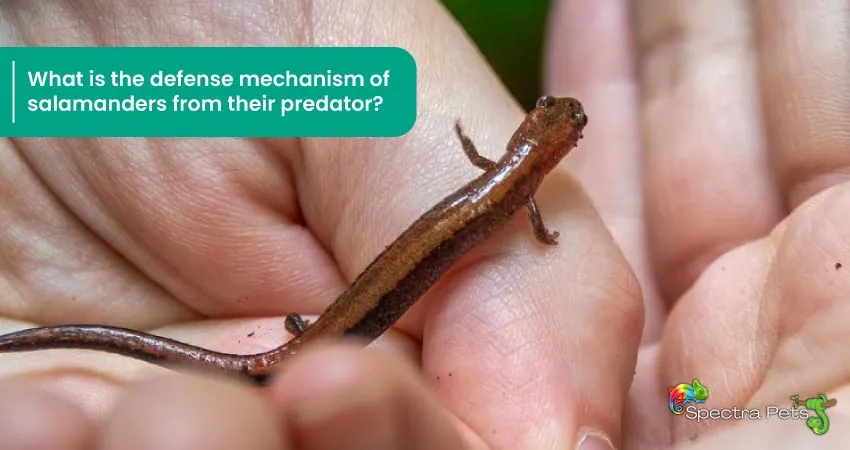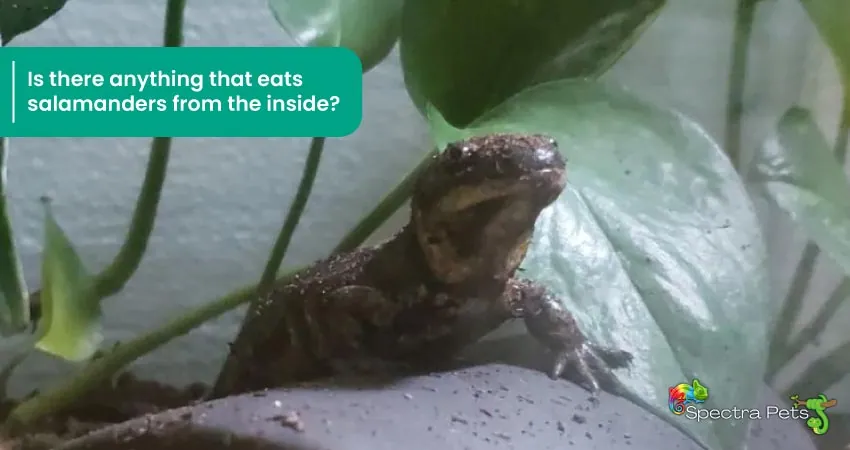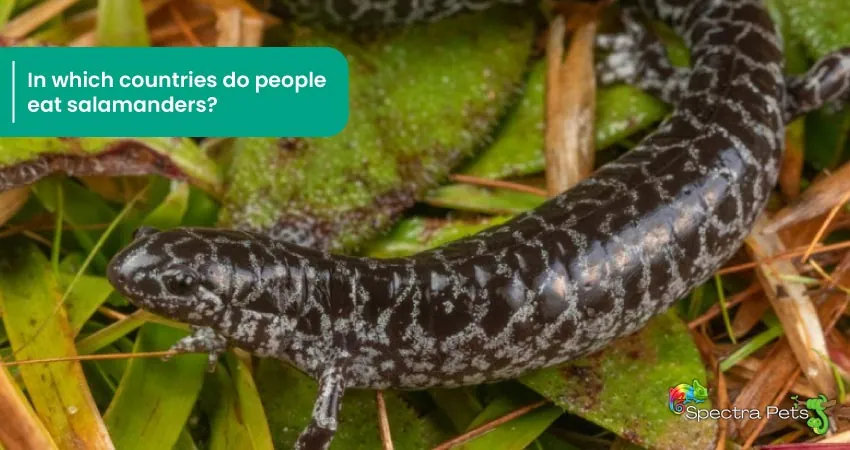A beautiful creature like a salamander is in a tricky position on the natural food chain where they have a long list of predators in the wild habitat.
In nature, salamanders have to go through the larvae stage, the juvenile stage, and finally the adult stage. The combination of their body size, defensive approach, and adaptation helps them to be a 24/7 potential predator. But they’re equally potential prey for others.
In every step of life, salamanders have different levels of predators. At larvae-stage salamanders are eaten by aquatic bugs, newts, crayfish, and some species of fish.
When they reach juvenile and adult stages, unfortunately, the predator list gets longer which includes wading birds, versatile snakes, raccoons, mammals, larger fish, turtles, otters, skunks, etc.
Now, we’re going to look at what a salamander eats in more detail in the following paragraphs. So, let’s begin..
Salamander’s greatest foes: A list of predators that eat Salamanders
The predator list for juvenile and adult salamanders will vary from one place to another due to different levels of biodiversity levels. Here in the following, you will explore varieties of salamander species and their predators in nature.
| Salamander Species | Predators | Range |
|---|---|---|
| Marbled Salamander | Owls, weasels, skunks, snakes, raccoons | Eastern USA, Texas, Illinois, Northern Florida |
| Newts, insects (eggs) | ||
| Spotted Salamander | Newts, crayfish (eggs) | Atlantic Coast, Texas, Eastern Forest of USA, South Carolina Mountain Area |
| Other salamander species, snakes, fish, bugs | ||
| Blue-Spotted Salamander | Birds, raccoons, aquatic species, fishes, dogs | Indiana, Northern New Jersey, Illinois, and more |
| Red Hills Salamander | Snakes, opossums, owls, raccoons, feral pigs | Alabama |
| Texas Salamander | No natural predator | Texas |
| Red Salamander | Woodland birds, skunk, raccoons | Kentucky, Ohio, Indiana, Virginia, New York, Michigan, Alabama |
| Mole Salamander | Bluegills (eggs), snakes, racers, water snakes | Indiana, Kentucky, Virginia, Ohio, Canada, Mexico, Northern Florida |
| Northern Dusky Salamanders | Garter snakes, red salamanders, skunks, raccoons | North Carolina, Kentucky, Michigan, Tennessee, Ohio, Indiana |
| Olympic Torrent Salamander | Garter snakes, giant salamanders | California, Washington, Northwestern Oregon |
| Mole Salamander | Black racers, wading birds, ribbon snakes | Indiana, Ohio, Illinois, Carolina, Virginia, Florida, Texas, Missouri, Tennessee |
| Cave Salamander (Spotted Tail Salamander) | Squirrels, skunks, snakes, raccoons, turtles | Tennessee, Georgia, Alabama, Michigan, Ohio, Indiana, Minnesota, Missouri |
| Eastern Tiger Salamander | Badgers, owls, snakes, bobcats | Atlantic Coast, Long Island, Kentucky, Mississippi, Louisiana, and more |
| Fire Salamander | Grass snakes, hawks, larger reptiles, eagles | Southern Europe, Eastern Asia |
| Long-Tailed Salamander | Sculpins, sunfish (larvae) | Appalachian Highland, Virginia, Pennsylvania, and more |
| Pygmy Salamander | Spring salamander, carabid beetles | Virginia, Georgia, North Carolina |
| Four-Toed Salamander | Fish, other salamanders, aquatic beetles (larvae) | New England, Minnesota, Gulf of Mexico, Appalachian Mountain Range |
| Small-Mouthed Salamander | Blue jays, water snakes, garter snakes, dragonfly larvae | Ohio, Missouri, Nebraska, Kentucky, Gulf of Mexico, Tennessee |
| California Tiger Salamander | Fish, bullfrogs, Great Blue Herons | Central California, Eastern Foothills |
| Common Mudpuppy | Large turtles, herons, otters, crayfish, snakes, hellbenders, large fish | Georgia, Mississippi, North Carolina, and more |
| Japanese Giant Salamander | No natural predator | Japan |
| Black-Bellied Salamander | Aquatic insects, other salamanders, fishes (eggs) | Georgia, North Carolina, Virginia, Tennessee |
| Northern Slimy Salamander | Snakes | Texas, New York, Illinois, Florida, and more |
| Red-Backed Salamander | Large frogs, snakes, raccoons, opossums, crows, skunks, jays, robins | Minnesota, North Carolina, Tennessee, and more |
| Fire-Bellied Newt | Birds | Japan & China |
| Hellbender | Other salamanders, water snakes, turtles, raccoons (young); minks, otters, raccoons (adult) | New York, Illinois, Mississippi, and more |
| Eastern Newts | Larger salamanders, snakes, raccoons, turtles, birds, fish, turtles | Florida, Texas, Ontario, Great Lakes, Canada |
| Northern Spring Salamander | Watersnakes, Gartersnakes | Appalachian Mountain, Alabama, Ohio, Ontario, and more |
| Alpine Newt | Fish (larvae), birds, rats, hedgehogs, grass snakes, ducks (adult) | France, Romania, Mediterranean, the Alps, and more |
| Ensatina Salamander | Garter snakes, scrub jays, raccoons | Washington, California, Oregon |
| Two-Toed Amphiuma | Wading birds, rainbow snakes, mud snakes, cottonmouths, water snakes | Louisiana, Florida, Virginia, Atlantic Coast |
| Green Salamander | Ringneck snake, black rat snake | Indiana, Carolina, Pennsylvania, Alabama, and more |
| Jefferson Salamander | Garter snakes | California, Southeastern Alaska, Pacific Coast |
| Seepage Salamander | Spring salamander, ringneck snake | Alabama, North Carolina, Georgia, Tennessee |
| Imitator Salamander | Birds, spring salamanders, mammals, snakes | North Carolina, Tennessee, Great Smoky Mountains |
Hopefully, this table showed you data easily that took hours to make and you can enjoy the information at one glance.
What is the defense mechanism of salamanders from their predator?
To save themselves from their potential predator, salamanders have some defense mechanisms which help them to a certain level. If these critters were not blessed with fine-tuning defense features, it would have been very tough for them to live in nature.

Toxins
First of all, salamanders can secret sticky, poisonous, and bad taste substances from the skin which makes them bitter taste food for their predator. So the predator often moves out leaving them alive.
Fire salamanders are a great model of this which squirt toxins directly on their enemies for protection.
A huge species of newts falls in the salamander category and they are also experts to ward off their predators using some chemicals. Newts secret milk-like substances from their skin which are poisonous to their predator.
But secreting toxins doesn’t make them lethal. If you’re thinking that salamanders are poisonous to the point of death, then you have nothing to worry about as long as you’re a normal human.
Color
You will be shocked to see the endless color variation of different salamander species. And all these color blendings on their skin help them to survive in the forest.
Some species of salamander show their stomach color by arching their back which gives the potential predator a signal to not mess with them. A good example of this is a Rough-skinned newt. This process is known as Unkenreflex and it’s an ultra-effective tool for them.
Camouflage
Plethora of colors makes the entire salamander species an unique species on the phase of earth. These little fellas have hundreds of color variations which include red, orange, yellow, black, gray, blue, black, brown, yellow, green, etc.
Due to this color combination salamanders can easily become invisible and hard to see on the forest floor or tree branches. This natural camouflage system helps them a lot to live a long life.
Dropping their tail
If unfortunately, a salamander gets under the bite hold of any predator some of them can drop their tail which allows them to escape. Then the predator gets busy with the tail part while the salamander runs away.
Here the good thing is they can regrow their tail after a specific time period. Some salamanders that drop tails are greenhorn mountain slender salamanders, sharp ribbed newts, rough-bellied newts, rough-skinned newts, etc.
Is there anything that eats salamanders from the inside?
Though salamanders have some awesome natural protection abilities they are not free from the attacks of a few parasites.
The most common one is a leech which is also called a flatworm. This parasite keeps feeding the salamander’s blood which leads to anemia and further health problems.
Moreover, some parasites like roundworms, flukes, tapeworms, etc can get into the intestine, mouth, and nose and keep making them weak by eating from their inner body parts.

In which countries do people eat salamanders? Do humans eat salamanders?
It’s been hundreds of years of tradition in China to eat Chinese giant salamanders as a luxury food. Due to the over-collection of this species, their number in wild has gone close to extinction level.
Some studies found that even in japan though it’s illegal to catch salamanders, some people still hunt them as a luxury food.
Apart from these two countries, no other country’s people consume salamanders as table food.

Frequently asked questions
What animal kills salamanders?
Salamanders are killed by a large variety of animals. There are many different salamander predators, however, the most common and feared ones are usually snakes and large amphibians such as frogs or newts.
Certain species of salamanders have been known to be eaten by beavers, raccoons and other small mammals. Some salamanders have even been eaten by humans, but this is extremely rare.
Will fish eat salamanders?
Yes, fish like Sunfish just love eating salamanders in their natural habitat. Moreover, tiger salamander larvae are often eaten by bass, muskie, and walleye.
Do squirrels eat salamanders?
Not all salamander species are hunted down by squirrels. Spotted salamanders are a favorite meal of squirrels.
Do raccoons eat salamanders?
Yes, salamanders are one of the top-notch and most accessible food for raccoons.
Is a salamander a predator or prey?
Almost all salamanders are both predator and prey. While few species like Japanese giant salamanders, Chinese giant salamanders in their adulthood do not have a natural predator.
What birds eat salamanders?
Varieties of birds like egrets, wading birds, great blue herons, blue jays, gray jays, eagles, and shore birds etc prey on salamanders in the wilderness.
Do bears eat salamanders?
No! Bears have no interest in eating species like salamanders, frogs and snakes etc.
Protect your salamander!
Wow, who knew salamanders had so many threats? But now you do, which is the most important part. It is up to you now, to set up a habitat that will keep your pet salamander healthy and safe. Although they have their own defense mechanisms, you have some responsibility too.
Hopefully, this article has given you a better understanding of what animals eat Salamanders. Wishing you a lovely day with your Salamander.
